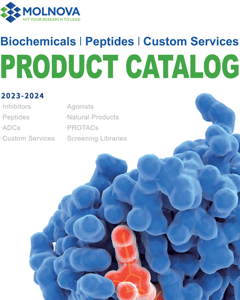
2,5-dimethoxycyclohexa-2,5-diene-1,4-dio
CAS No. 3117-03-1
2,5-dimethoxycyclohexa-2,5-diene-1,4-dio( 2,5-Dimethoxybenzo-1,4-quinone | 2,5-Dimethoxybenzoquinone | Thermophillin | 2,5-DMBQ )
Catalog No. M29471 CAS No. 3117-03-1
2,5-dimethoxycyclohexa-2,5-diene-1,4-dio is a natural product. The redox cycle of 2,5-dimethoxybenzoquinone is a source of reducing equivalent for the regeneration of Fe2+ and H2O2 in brown rot fungal decay of wood.
Purity : >98% (HPLC)
 COA
COA
 Datasheet
Datasheet
 HNMR
HNMR
 HPLC
HPLC
 MSDS
MSDS
 Handing Instructions
Handing Instructions
| Size | Price / USD | Stock | Quantity |
| 50MG | 45 | In Stock |


|
| 100MG | Get Quote | In Stock |


|
| 200MG | Get Quote | In Stock |


|
| 500MG | Get Quote | In Stock |


|
| 1G | Get Quote | In Stock |


|
Biological Information
-
Product Name2,5-dimethoxycyclohexa-2,5-diene-1,4-dio
-
NoteResearch use only, not for human use.
-
Brief Description2,5-dimethoxycyclohexa-2,5-diene-1,4-dio is a natural product. The redox cycle of 2,5-dimethoxybenzoquinone is a source of reducing equivalent for the regeneration of Fe2+ and H2O2 in brown rot fungal decay of wood.
-
Description2,5-dimethoxycyclohexa-2,5-diene-1,4-dio is a natural product. The redox cycle of 2,5-dimethoxybenzoquinone is a source of reducing equivalent for the regeneration of Fe2+ and H2O2 in brown rot fungal decay of wood.
-
In Vitro——
-
In Vivo——
-
Synonyms2,5-Dimethoxybenzo-1,4-quinone | 2,5-Dimethoxybenzoquinone | Thermophillin | 2,5-DMBQ
-
PathwayOthers
-
TargetOther Targets
-
Recptor——
-
Research Area——
-
Indication——
Chemical Information
-
CAS Number3117-03-1
-
Formula Weight168.148
-
Molecular FormulaC8H8O4
-
Purity>98% (HPLC)
-
Solubility——
-
SMILESCOC1=CC(=O)C(OC)=CC1=O
-
Chemical Name——
Shipping & Storage Information
-
Storage(-20℃)
-
ShippingWith Ice Pack
-
Stability≥ 2 years
Reference



-
Tidutamab
Tidutamab (XmAb-18087) is a humanized bispecific antibody targeting the growth inhibitory receptor 2 (SSTR2) and T-cell binding domain (CD3) with antitumor activity for the study of gastric neurosecretory tumors.
-
CID1375606
CID 1375606 is a surrogate agonist of orphan G protein-coupled receptor?GPR27. characterized by a high level of conservation among vertebrates and a predominant expression in the central nervous system.
-
Gastrin-Releasing Pe...
Gastrin-releasing peptide is a regulatory human peptide that elicits gastrin release and regulates gastric acid secretion and enteric motor function. The post-ganglionic fibers of the vagus nerve that innervate the G cells of the stomach release GRP, which stimulates the G cells to release gastrin.



 Cart
Cart
 sales@molnova.com
sales@molnova.com


